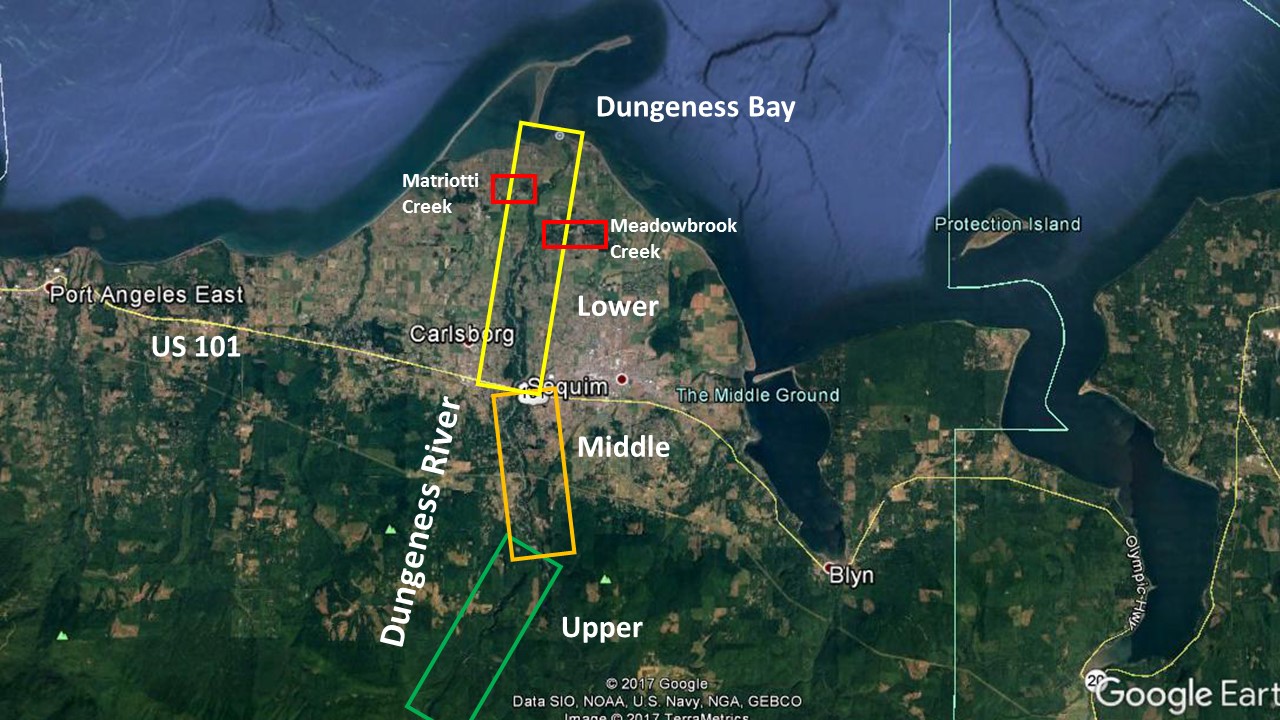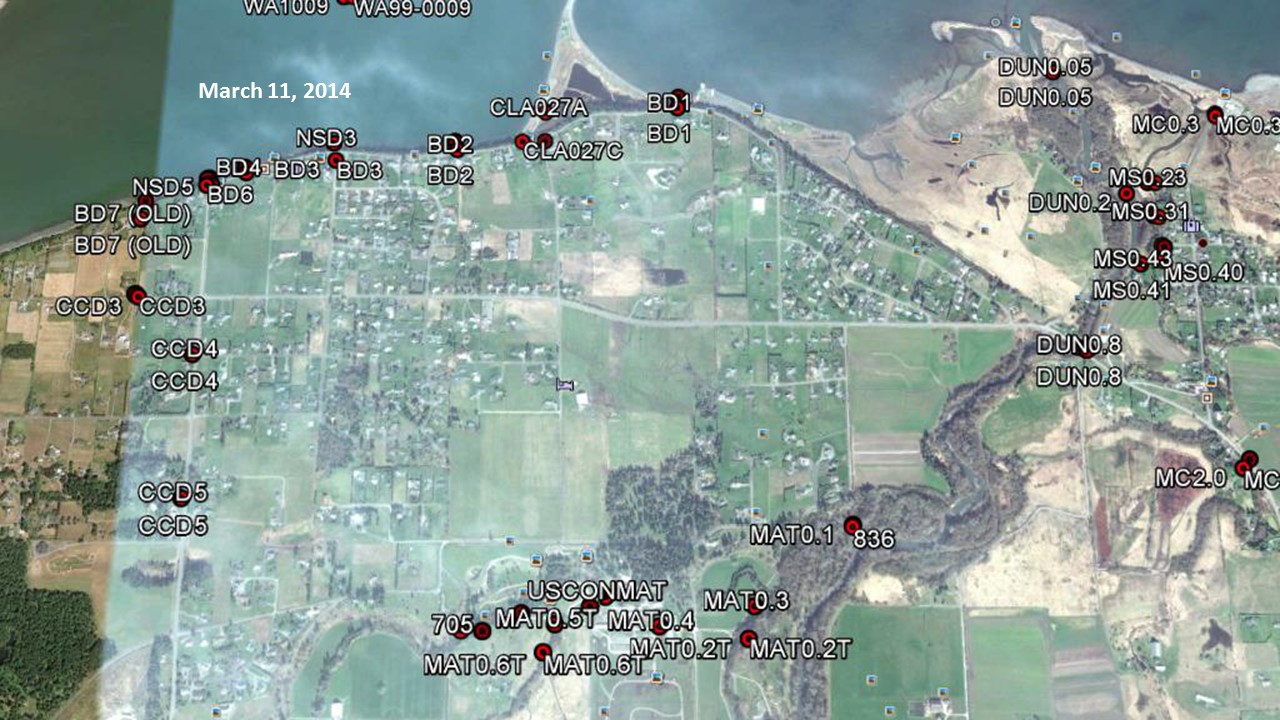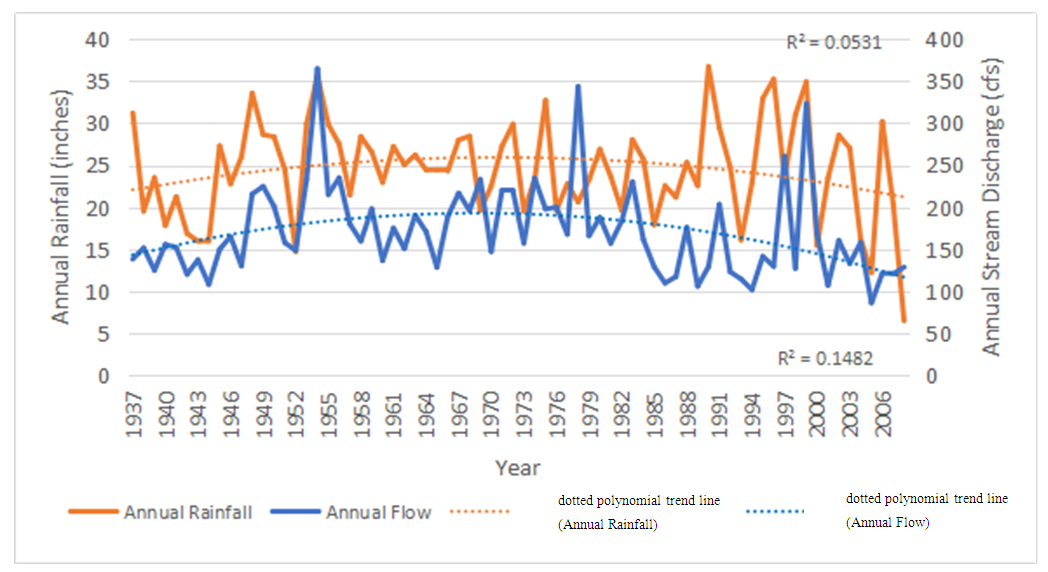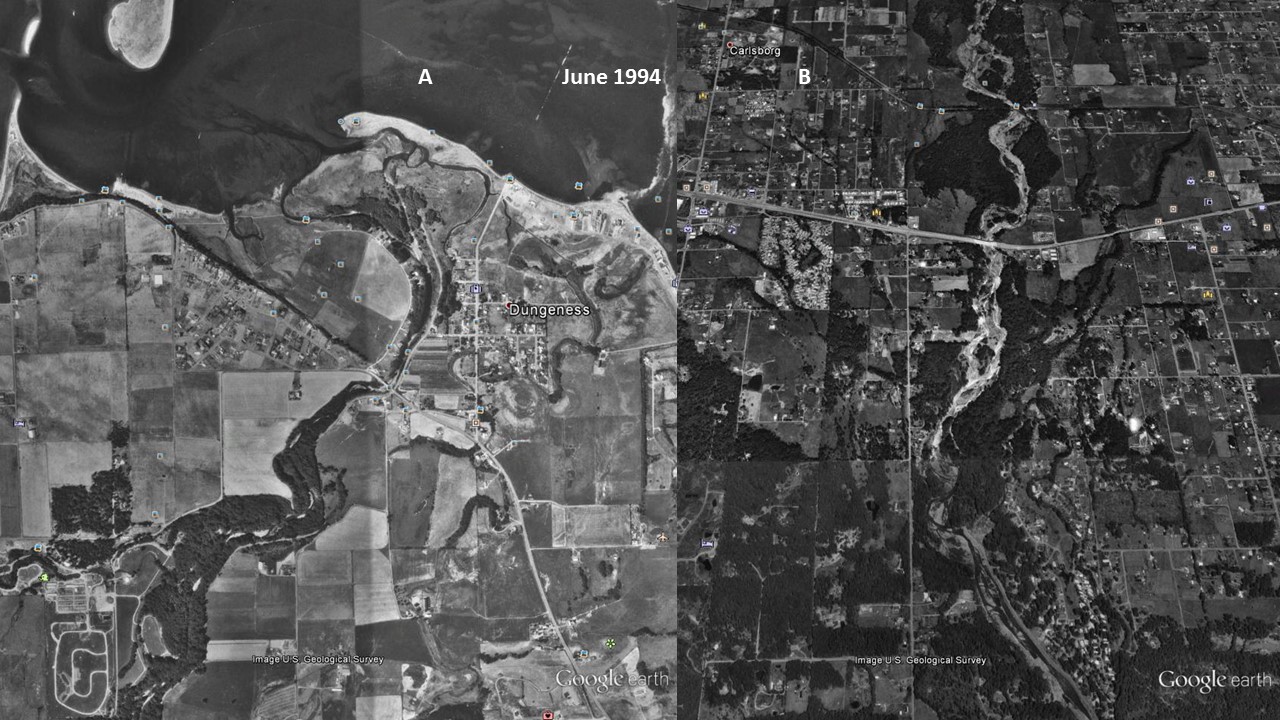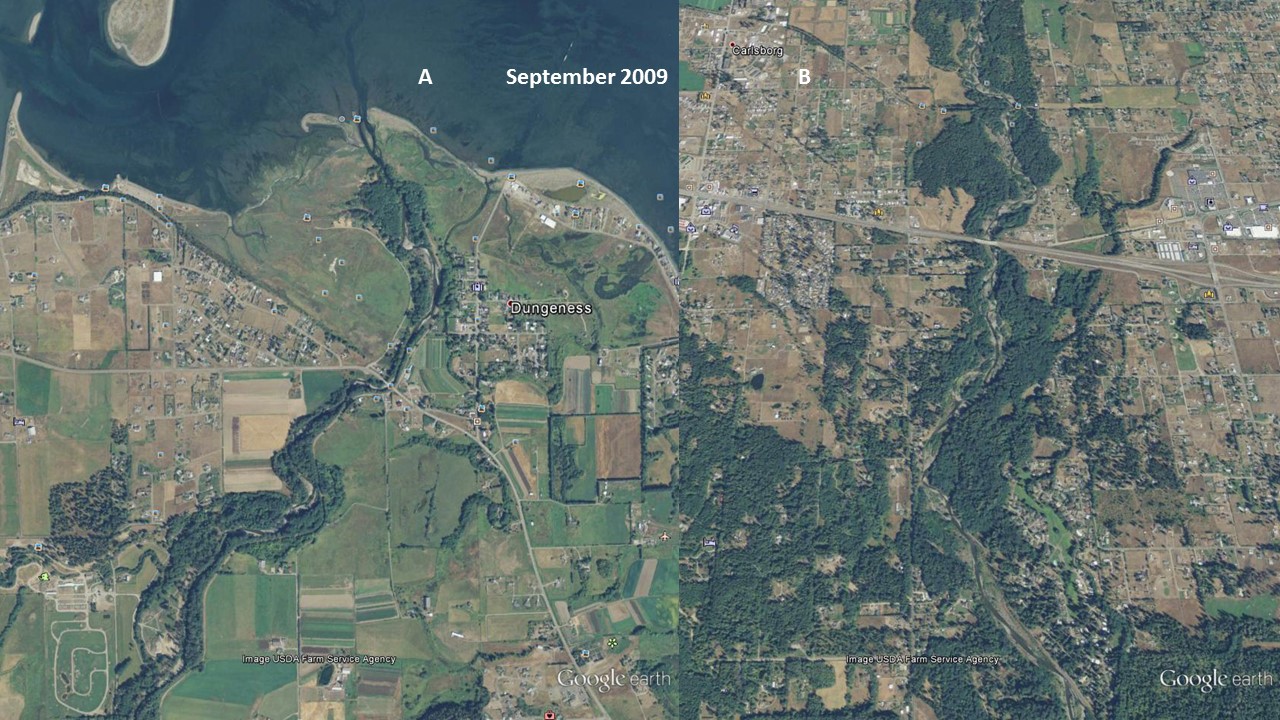-
Paper Information
- Paper Submission
-
Journal Information
- About This Journal
- Editorial Board
- Current Issue
- Archive
- Author Guidelines
- Contact Us
American Journal of Environmental Engineering
p-ISSN: 2166-4633 e-ISSN: 2166-465X
2019; 9(2): 36-54
doi:10.5923/j.ajee.20190902.03

Assessing Dungeness River Functionality and Effectiveness of Best Management Practices (BMPs) Using an Ecological Functional Approach
Eric S. Hall1, Robert K. Hall2, Sherman Swanson3, Wilson Yee2, Don Kozlowski4, Michael J. Philbin5, Daniel T. Heggem6, John Lin6, Joan L. Aron7, Robin J. Schafer8, David Guiliano2, Eric Wilson9
1USEPA Office of Research and Development, NERL, Systems Exposure Division (SED), Ecological and Human Community Analysis Branch, Research Triangle Park, NC
2USEPA Region IX, WTR2, 75 Hawthorne St., San Francisco, CA
3Ecology, Evolution and Conservation Biology, University of Nevada, 1664 N. Virginia St., Reno, NV
4US Forest Service, Sequoia National Forest, Western Divide Ranger District, Springville, CA
5U.S. Dept. of the Interior Bureau of Land Management, Montana/Dakotas State Office, 5001 Southgate Drive, Billings, MT
6USEPA Office of Research and Development, NERL, Systems Exposure Division (SED), Ecosystem Integrity Branch, Las Vegas, NV
7Aron Environmental Consulting, 5457 Marsh Hawk Way, Columbia, MD
8University of Puerto Rico, Río Piedras Campus, 14 Ave. Universidad, Ste. 1401, San Juan, PR
9Gulf Coast STORET, LLC, 11110 Roundtable Dr., Tomball, TX
Correspondence to: Eric S. Hall, USEPA Office of Research and Development, NERL, Systems Exposure Division (SED), Ecological and Human Community Analysis Branch, Research Triangle Park, NC.
| Email: |  |
Copyright © 2019 The Author(s). Published by Scientific & Academic Publishing.
This work is licensed under the Creative Commons Attribution International License (CC BY).
http://creativecommons.org/licenses/by/4.0/

Effective stream and wetland Best Management Practices (BMPs) restore the physical processes associated with ecological functions to their Proper Functioning Condition (PFC, i.e., the highest attainable ecological status of a riparian area without consideration of economic, administrative, or social constraints). Ecological functions connect stream monitoring and management to mitigate the causes of ecosystem degradation and enhance restoration. The ecological function approach supports sustainable management of many ecosystem services including water quality, water stability (aquifer recharge), and fish and wildlife habitats. The 1993 Forest Ecosystem Management Assessment Team (FEMAT) report listed the Dungeness River as a Tier 1 key watershed, noted that watersheds are the logical spatial unit for ecosystem management, and that watersheds are important in species management, and understanding the interdependence of physical processes. Watersheds are at the spatial scale where physical and biological disturbances can be observed, and where management constraints and planning options for restoration objectives and strategies can be readily assessed. The US Forest Service (USFS) developed a management strategy for the Middle Dungeness River, and in the 1990s, the Upper Dungeness River was listed as impaired due to sediment, which initiated a US Forest Service change to land management practices. The Lower Dungeness River and bay are listed as impaired due to fecal coliform contamination. Assessing and monitoring the drivers of ecosystem function (vegetation, hydrology, soil, and landform) as part of a watershed adaptive management plan, and implementing BMPs to increase ecological functions, will improve aquatic habitat and water quality. Most BMPs, such as Total Maximum Daily Loads (TMDLs), attempt to improve water quality by reducing the amount of external pollutants reaching the impacted waterbodies, but do not focus on improving the watershed functions. The Proper Functioning Condition (PFC) approach is used to examine the condition of wetlands and streams and provide guidance for quantitative approaches (e.g., TMDL, remote sensing) used in watershed restoration. Improving watershed functions is a BMP that facilitates increased flows of water, nutrients, sediment, and other materials, and improves habitat quality. Using improved watershed functions as a BMP, facilitated by the use of remote sensing, TMDLs, and the PFC methodology is a more effective means of reducing risks across a watershed than by using TMDLs alone.
Keywords: Best Management Practices (BMPs), Potential Natural Condition (PNC), Proper Functioning Condition (PFC), Total Maximum Daily Load (TMDL), Watershed Condition Framework (WCF), Non-Point Source (NPS), Point Source (PS), Fecal coliform, Ecological function
Cite this paper: Eric S. Hall, Robert K. Hall, Sherman Swanson, Wilson Yee, Don Kozlowski, Michael J. Philbin, Daniel T. Heggem, John Lin, Joan L. Aron, Robin J. Schafer, David Guiliano, Eric Wilson, Assessing Dungeness River Functionality and Effectiveness of Best Management Practices (BMPs) Using an Ecological Functional Approach, American Journal of Environmental Engineering, Vol. 9 No. 2, 2019, pp. 36-54. doi: 10.5923/j.ajee.20190902.03.
Article Outline
1. Introduction
- The Clean Water Act (CWA), also known as the Federal Water Pollution Control Act (FWPCA), is a key tool in regulating water pollution [9]. Success of the water programs (e.g., CWA Section 303(d), Total Maximum Daily Load (TMDL) source assessment, and; CWA, Section 319) can be measured by the NPS project funding tracking system called the Grants Reporting and Tracking System (GRTS: Webpage - https://iaspub.epa.gov/apex/grts/f?p=grts:95; Accessed: 12 Oct 2019). GRTS is the central oversight, management, and data-sharing tool for the Section 319 Program, used to assess and prioritize the control of point source (PS) and nonpoint source (NPS) water pollution, and is based on identifying actions for attaining water quality standards through the CWA [9], [10]. The USEPA 2004 National Water Quality Inventory Report to Congress [11] indicates that approximately 44% of rivers and streams, and 64% of lakes and reservoirs surveyed are impaired for fishing, swimming, and other uses. The primary causes of impairment are pathogens, habitat alterations, nutrients, and other factors. This report raises some interesting questions about the USEPA’s water quality program, and its ability to deal with NPS pollution. After more than 35 years of implementing the CWA and investment of billions in public [12] and private funds [13], states acknowledge that NPS pollution is the most important remaining cause of water quality problems (Webpage: https://www.epa.gov/nps/basic-information-about-nonpoint-source-nps-pollution; Accessed 12 Oct 2019).
1.1. Ecosystem Management Considerations
- Bernhard et al., [14] noted that funding [12], [13] for improving quality and in-stream habitat does not provide the necessary data and information for evaluating the ecological effectiveness of restoration activities. The questions for state and tribal environmental managers are: how to assess and prioritize water quality in areas (e.g., the Upper Reese River in Nevada [7], or in Illinois, Pennsylvania, Maryland, Virginia, and West Virginia [15] where implementation of Best Management Practices [BMPs] is needed); what are the most effective BMPs [16], and; how to monitor BMP effectiveness [6], [8]. Giri et al., [17] evaluated targeted methods for BMP implementation, and found BMP efficiencies vary, depending on design, maintenance, and placement within the watershed [4], [15], [18], and [19]. Physically, ecosystems are dynamically affected by biogeoclimatic setting and anthropogenic modification of natural conditions. Changes in ecological condition, affect the chemical and biological community structure, causing further alterations to the physical, chemical, and biotic environment. Variability, in ecosystem structure and function and in pollution sources, impacts the effectiveness of potential environmental solutions [17].Sources of pollution can be external (point sources and some nonpoint sources, such as runoff of anthropogenic chemicals) or internal, expressed as altered concentrations of naturally occurring materials (e.g., decreased flow, channel incision, etc.). These pollution sources result in an ecosystem with altered functioning of its physical processes. Effective solutions focus on the drivers of ecosystem functioning (vegetation, hydrology, soil, and landform). External pollutants/stressors create problems with water quality (e.g., nutrients, trace metals, temperature, pH, dissolved oxygen) and/or habitats (substrate, water depth, velocity, temperature, insolation, etc.) [16]. An appropriate management strategy incorporates ecosystem patterns, attributes, and processes to sustain ecosystem functions, and support biological diversity, including a range of environmental processes and associated variations.The central focus of an ecosystem management strategy should be on physical processes, emphasize ‘self-healing’, and prioritize actions which maintain, and restore, the necessary conditions for ecosystem resilience and restoration. Most states and tribes prioritize their waterbodies for TMDL development, and/or BMP implementation, using a statewide scheduling process, that reviews and assesses water quality problems listed on the most recent CWA Section 303(d) list of impaired waters for their state or tribal region. The objective of this process is to enhance, and accelerate, efforts to restore impaired water quality through watershed planning, and implementation of TMDLs. It is important to obtain stakeholder involvement in developing TMDLs, and implementing BMPs [10]. However, without the subsequent step of determining the relative contribution of external versus internal (altered concentration of natural materials) pollutants, and the driving mechanisms causing altered concentrations, any planned restoration activities (corrective actions), undertaken as a result of this process, may be incomplete, and could be ineffective. USEPA developed the Nitrogen and Phosphorus pollution Data Access Tool (NPDAT), to assist states and tribes in these efforts (Webpage: http://water.epa.gov/scitech/swguidance/standards/criteria/nutrients/npdat_index.cfm - Accessed: 12 Oct 2019). As seen in the literature, the majority of BMPs focus on water quality and external pollutants [4], not on watershed functions [5]. Thus, most of the state and tribal approaches are based on how the ecosystem functions, its resiliency to perturbation, or its ability to assimilate stressors. However, it is the adjustments in watershed (ecological) functions that provides resilience, through preventing, and, when required, processing surges in water, nutrients, sediment, and other materials, and by improving habitat quality [6], [7], and [8]. The quality of a stream, and wetland riparian ecosystem, directly relates to the adjacent uplands, and the ‘up-stream’, and ‘down-stream’ conditions. Improved knowledge of aquatic and upland interactions, solely focused on the riparian zone at local watershed scales, is essential in evaluating and designing land management approaches for improving stream and riparian wetland resources.
1.2. Best Management Practices (PFC, Remote Sensing, TMDL)
- Wyman, et al., [20] indicate that water quality, and channel morphology measurements, are not appropriate tools to evaluate BMP strategy changes in the short-term. Significant assimilative capacity of a stream and wetland stems from riparian vegetation, especially obligate vegetation [7], [21], [22], [23], and [24]. Vegetation attribute measurements may be more appropriate, because they are the first to react to stress, and are drivers of ecosystem change. Water quality, and aquatic community structure, depend on the amount, and timing, of water flowing through the system. Hydrology also depends on climate, weather, and sometimes water rights (which are outside of a manager’s control). Consequently, ecosystem improvement, and the adequacy of a management strategy (i.e., BMPs), can be understood by monitoring riparian conditions, and the attributes important in sustaining ecosystem functionality. Understanding the expected recovery rates, for a specific riparian area, helps in developing achievable objectives, that can be met, within a designated timeframe, through adaptive management.Prichard et al., [22] defines the Properly Functioning Condition (PFC) of a stream, and wetland riparian ecosystem, as having the ability to: “Dissipate stream energy associated with high water flows, thereby reducing erosion and improving water quality; filter sediment, capture bedload, and aid floodplain development; improve floodwater retention and groundwater recharge; develop root masses that stabilize streambanks against cutting action; develop diverse ponding and channel characteristics to provide the habitat and the water depth, duration, and temperature necessary for fish production, waterfowl breeding, and other uses, and; support greater biodiversity.” This is the most desirable condition, and the highest PFC rating, that a stream or wetland riparian system can attain.The purpose of this paper is to: a) explain the concept of the Proper Functioning Condition (PFC) methodology [24] in assessing stream and wetland attributes, prioritizing resources, and providing a context for quantitative approaches; b) illustrate the importance of Remote Sensing (along with hydrographs and reports) in tracking and documenting change that can be assessed by PFC; c) describe the impact of regulatory, educational, and management action in improving Total Maximum Daily Load (TMDL) levels (fecal coliform), and; d) explain how PFC, Remote Sensing (along with hydrographs and reports), and TMDL can be used together as a Best Management Practice (BMP) in assessing the functionality of riparian-wetland areas.
2. Methods
2.1. Study Area
- The Dungeness River headwaters are in the northeastern portion of the Olympic National Forest, and discharge into Dungeness Bay, and the Strait of Juan de Fuca, on the eastern side of Sequim WA (Figure 1a and Figure 1b). The Lower and Middle Dungeness River are low to moderate gradient sinuous (wandering back and forth across the floodplain, in an ‘S-shaped’ pattern) stream channels. The Dungeness River Restoration Work Group (DRRWG) [39] identified excessive flooding, and declining stocks of salmon, to be the result of loss of important physical processes and riparian functions. The DRRWG Report [39], indicated that protection of self-sustaining salmon stocks in the Dungeness River required an approach that recognized, and restored, important river functions relevant to local potential.
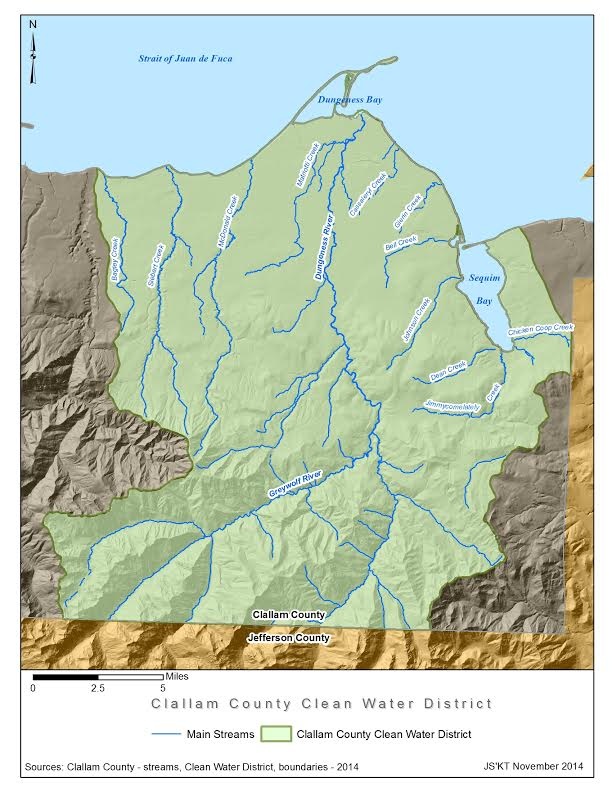 | Figure 1b. Map of the Dungeness River Watershed, including clean water district boundaries (2014). Sources: Clallam County and Jamestown S'Klallam Tribe |
2.2. Assessment Strategy/Approach
- Assessing stream and wetland functionality involves determining a riparian area’s potential using local knowledge (historic photographs, survey notes, and/or documents indicating historic condition), species lists (historic animals and plants), soils, hydrology, geomorphology, identifying currently existing vegetation, monitoring of pollutants and pathogens, and any limiting factors (human-caused and natural), to determine if they can be corrected. Most of these limiting factors can be rectified through proper management [6], except for permanent construction (e.g., dams, diversions, permanent channel modifications), which is not as easy to modify, since the placement of permanent structures can result in a stream-wetland area’s flow regime being modified to a new (altered) potential. In this study, PFC, TMDL, and remote sensing (along with hydrographs and historical report information) are used together to develop a more complete picture of the status of the area and how to improve the functionality of the riparian-wetland area.
2.3. Total Maximum Daily Load (TMDL)
- The area between Port Angeles and Sequim, Clallam County WA experienced 16% growth between 1990 and 2000. Fecal coliform bacteria has been increasing in Dungeness Bay since 1997 [37]. In May 2000, the Washington Department of Health closed 300 acres of Dungeness Bay to commercial shellfish harvesting [38]. In May 2001, the Washington Department of Health added another 100 acres to the closure area, because bacteria concentrations exceeded the State and Federal water quality standards.TMDLs focus on quantitative water quality measurements, and their impacts to human health and aquatic communities [25]. When dealing with NPS pollution (e.g., sediment, nutrients, pathogens), water quality and aquatic organisms are response (lagging) indicators [25], [26], and [27]. To address aquatic impacts from environmental stressors, it is important to understand the drivers of ecosystem function (vegetation, hydrology, soil, and landform), and recognize their role in the capture, storage, and safe release of water, sediment, nutrients, and organic materials. TMDL data was used to assess the impact of state and tribal corrective actions on fecal coliform levels.
2.4. Proper Functioning Condition (PFC)
- Proper Functioning Condition (PFC) is a qualitative, science-based approach, used to assess stream and wetland hydrologic, vegetative, and geomorphic attributes and processes accomplished by a multidisciplinary/interdisciplinary team (ID team), at a point in time [24], [28], [29], and [30]. Natural riparian-wetland areas are best understood through the interactions between the vegetation, hydrology, soil, and geology of those areas. Therefore, assessing the functionality of a riparian-wetland area requires an interdisciplinary (ID) team, including specialists in vegetation, hydrology, soils, and geology. The team must include a biologist who understands the fish and wildlife in the specific riparian wetland area(s) being studied. PFC is also an appropriate starting point for determining, prioritizing, and inventorying riparian resources, developing monitoring needs [31], and providing context for quantitative data (e.g., TMDLs). An ID team must understand stream dynamics, and potential, and use their professional experience, and judgment, to accurately complete a qualitative assessment [28]. Use of quantitative data and techniques (i.e., field measurements, [32], [33], and remote sensing [34]) is encouraged for individual, or team calibration, or where opinions may differ [24].The term PFC is both a methodology, used to assess the (physical) functioning of riparian-wetland areas, and a description of the (most desirable) condition of riparian-wetland areas. The PFC assessment methodology is defined in [28]. The Watershed Condition Framework (WCF) methodology is defined in [35] as a structured, integrated approach, for implementation, when restoring grasslands, national forests, and priority watersheds. The technical guidance for implementing the WCF methodology is defined in [36]. The PFC has 17 ecosystem indicators/attributes, grouped under 3 categories (hydrology, vegetation, and erosion/deposition) for lotic (rapidly-moving fresh water) ecosystems. The WCF has 12 watershed condition indicators, grouped under 4 categories (aquatic-physical, aquatic-biological, terrestrial-physical, terrestrial-biological). Despite the differences, the two methodologies provide overall assessments that align with each other as shown in Table 1. Given the more abundant literature on the PFC methodology, that is the approach which was selected for this analysis.
|
2.5. Remote Sensing and Supporting Data Sources
- The analysis of the Dungeness River included remote sensing imagery from the US Geological Survey (USGS) and US Department of Agriculture [40]. Because of the resolution of the imagery, only the mainstem of the Dungeness River, and the larger tributaries (Matriotti Creek and Meadowbrook Creek) in the Lower Dungeness River, were analyzed using the PFC protocol [22], [24], [34], [40], and [41]. Supporting data sources also included USGS hydrologic and water quality data, for the Dungeness River, and the US Environmental Protection Agency (USEPA) Storage and Retrieval (STORET) data management system data, for the entire state of Washington. The Dungeness River was divided into three reaches (i.e., level, uninterrupted lengths with similar hydrological conditions), Upper (upstream of the USFS boundary), Middle (USFS to US 101), and Lower (US 101 to shoreline) (Figure 1a), and matches the USFS [42] assessment of the Upper Dungeness River, and Middle Dungeness River [2]. The remote sensing and historical reports were used to display and describe the changes over time caused by human activity and provide context for the overall assessment.
|
3. Results
- TMDL Assessment (Fecal Coliform) - To address the elevated bacteria concentrations, the state of Washington developed a Total Maximum Daily Load (TMDL) for fecal coliform in the Lower Dungeness River and Matriotti Creek [38]. Subsequent water quality evaluations show mixed results. Significant impacts on the river come from animal and human wastes, resulting from hobby farming, and poorly maintained septic systems [37]. Woodruff et al., [47] noted that by late 2009, the Washington Department of Health-initiated closures of the Dungeness Bay to shellfish harvesting were still in effect, indicating that fecal coliform contamination was still a problem. In the Dungeness River watershed, local and regional institutions have worked collaboratively for over 20 years to maintain and restore ecosystem functions [47]. With continued urban expansion, a variety of watershed ecosystem problems have continued and expanded (e.g., storm water runoff, excess sediment, impaired in-stream flows). Issues include the listing of salmonid species under the Endangered Species Act, and the closure of the Dungeness Bay to shellfish harvesting beginning in 2000 [37], [38], due to high levels of fecal coliform (FC) bacteria. These events indicate continued degradation of the Dungeness River ecosystem functions.In 2004 the Dungeness Bay was also listed as impaired by fecal coliform. The TMDL implementation plan was documented in the Water Cleanup Plan for Bacteria in the Lower Dungeness Watershed [37]. The predominant sources of fecal coliform contamination in freshwater and marine environments were, in rank order, avian (19.6%), gull (12.5%), waterfowl (9.7%), raccoon (9.2%), unknown (7.3%), human-derived (7.1%), rodent (6.3%), and dog (4.3%) [47]. Bird groups combined represented ~42% of the samples collected and analyzed [47]. Wildlife represented ~26% of isolates, and domestic animal and livestock groups each represented approximately 7% of isolates [47]. Matriotti Creek (MAT0.1) had the highest frequency of occurrence of human sources, occurring in ~70% of samples collected and analyzed [47]. A subsequent Bacteroides fragilis (bacteria generally found in the human colon) Polymerase Chain Reaction (PCR) genetic profile study detected human and/or ruminant-derived source bacteria, indicating a wider spread of these sources throughout the lower watershed [47]. The TMDL-associated restoration activities (corrective actions) included piping of irrigation ditches, pasture management, manure storage, pumping and repair of septic systems, and outreach and education efforts with area residents. The Washington Department of Ecology targeted private landowners, because they were able to use their regulatory authority, and apply federal and state resources, to the restoration efforts. The Jamestown S'Klallam Tribe, and Clallam County, monitored fecal coliform bacteria levels at selected TMDL monitoring sites to determine the effectiveness of the restoration activities/corrective actions (Figure 2). The TMDL restoration activities continue to the present day.
4. Discussion
- The DRRWG Report [39] noted that the physical processes of sediment transport must be in balance with the hydrology and sediment transport within the watershed. The USFS [2] report found the absence of stabilizing large woody debris led to decreased channel sinuosity (i.e., straightening of the channel). Past land management activities (e.g., channelization, dewatering of wetlands, etc.), loss of large wood, and floodplain access, led to increased peak flow runoff (Figure 5). Increased peak annual flow (Figure 5), would have caused the river channel to straighten, and possibly, to incise, and become disconnected from the floodplain [2]. In 1994, the USFS altered their forest management plan from ‘clear-cutting’ to commercial thinning (Note: There are different contributory aspects to consider in changing the forest management approach from ‘clear-cutting’ to commercial thinning, such as the magnitude of the timber harvest, the mileage of the ‘high risk’ roads in the upper portion of the watershed over time, etc.). TMDLElevated fecal coliform levels in Dungeness Bay caused the closure of shellfish beds. The state of Washington used federal and state regulations and resources to improve the fecal coliform levels, through restoration activities, and educational outreach. Once the restoration activities were implemented, the Jamestown S'Klallam Tribe, and Clallam County, monitored fecal coliform at a number of sites to determine if the restoration activities and educational outreach efforts were effective. Overall, there were lower fecal coliform concentrations (with a few mid-to late-summer spikes) and the Dungeness River showed some improvement, while the Matriotti Creek still exceeds the fecal coliform standards.PFCThe PFC descriptive assessment provided an overall qualitative status of the riparian-wetland area, indicating that each of the three reaches of the Dungeness River were ‘Functional-At-Risk’ (FAR) with the Upper Dungeness River Reach being in the higher end of FAR status (shown as green in Figure 1a), the Middle Dungeness River Reach being in the middle range of FAR status (shown as yellow in Figure 1a), and the Lower Dungeness River Reach being in the middle one-third of FAR status (shown as light yellow in Figure 1a). Both the Matriotti Creek and Meadowbrook Creek were in the low end of FAR status to ‘Non-Functioning’ (shown as red in Figure 1a), due to agricultural practices and urbanization.Remote SensingAs seen in Figures 11, 12, and 13, the change in land management may have had an effect on reducing the variability in peak flow discharge. However, if riparian functions are improving, late/dry season flow should increase (Figure 5), because more water would be stored in the riparian wetlands, and also stored as groundwater (Figure 6). The downward movement of the blue (dotted) polynomial trend line in Figure 6 indicates that either management is having an effect, or there is a change in climatic conditions such as drought, and/or perhaps more precipitation as rain, with a reduced snowpack.The evolution of the area over time was documented through remote sensing satellite photographs, which displayed the condition of the area at different times, and displayed the changes that occurred due to human activity. The USGS hydrographs displayed the water flow changes over time, and those changes were linked changes in management strategies, which occurred at discrete points in time. Also documented reports by the US federal government and the state of Washington provided a fuller context on what was happening and why these events occurred. Changes in forestry practices and conversion of forest land to agricultural use had an impact on sediment load in the area. Additional land use changes seems to have had an impact on the watershed and the riparian ecosystem. The interplay between land use, hydrology, vegetation, soil and human activity can be understood through these tools and provides the information required for a meaningful PFC assessment. Remote sensing, and PFC analysis, should track, and be consistent with monitoring and human observation.
5. Conclusions
- Implementing a methodology to manage water quality for a riparian-wetland area requires three key elements that should be used together as a Best Management Practice (BMP): a) a visual and documentary record that illustrates the changes to an area over time, the source of the changes, and the context under which the changes occurred (remote sensing and historical reports); b) quantitative measurement and observation of the major water pollutants, sediment, nutrients, and pathogens that impact water quality, along with documentation of how corrective actions influenced water quality (TMDL and ‘before/after’ assessment of corrective actions), and; c) qualitative assessment of the riparian-wetland area that provides a description of the status of the current state of the area that can be used in planning adaptive management strategies to improve riparian-wetland functionality (PFC). This project used remote sensing (with hydrology and historical reports), to provide a documentary record and context, TMDL targets (fecal coliform) to assess the impact of corrective actions and educational outreach on improving water quality, and PFC to describe and characterize the current status, prioritize resources and plan management actions, and provide context for quantitative measurements.Managing water quality, by assessing functionality through PFC, enhances the sustainability of the entire ecosystem. Using a function-based approach enables everyone involved to adjust expectations as the ecosystem PFC changes in response to management options. Incorporating the pathogen (fecal coliform) TMDL implementation plan as part of a process, to achieve long-term success for stream stabilization, or restoration, and can be useful, even if it is a ‘lagging’ indicator, when used in context with other assessment (PFC), measurement (hydrology), historical (reports), and remote sensing (satellite pictures). Use of these three approaches in concert facilitates monitoring of the drivers of ecosystem function (vegetation, hydrology, soil, and landform) as a component of a watershed adaptive management plan, and is a Best Management Practices (BMPs) that can lead to increase of ecological function, and enhance the chances of improving aquatic habitat and water quality.Funding: This research was funded by the United States Environmental Protection Agency, through its Office of Research and Development.
ACKNOWLEDGEMENTS
- The authors would like to thank Katrina Varner and Yongping Yuan of the USEPA Office of Research and Development for their critical review of the manuscript, and the USEPA Office of Research and Development for funding this research. The authors would also like to thank Laurie Mann of USEPA Region 10. Although this work was reviewed by USEPA and approved for publication, it may not necessarily reflect official Agency policy. Mention of trade names and commercial products does not constitute endorsement or recommendation for use.
 Abstract
Abstract Reference
Reference Full-Text PDF
Full-Text PDF Full-text HTML
Full-text HTML